Gera
Gera is where my mother Toni Katz, her parents lived starting around 1921/1922, until their deportation (or escape for my mother) in November 1938.
Gera is a mid-sized industrial city in Thuringia (aprox. 100 000 inhabitants today), located east of Weimar and south of Leipzig. It was part of East Germany until German reunification.
From literaturland-thueringen :
Around 1900 Gera was one of the richest cities in Germany. From the middle of the 19th century, the city on the White Elster river - until 1918 the state capital of the Principality of Reuss-Gera (Fürstentum Reuß jüngerer Linie), and until 1920 of the People's State of Reuss (Volkstaates Reuß)- recorded enormous economic growth, thanks in particular to the development of the local textile and mechanical engineering industry.
During that period, the city experienced an explosive population growth, and the increasing wealth of the city was reflected in the construction of around 100 Wilhelminian-style villas, especially in the city center, in the area of Berliner Straße, which still provide information about this glamorous period. Gera was the second city in Germany to build a tram in 1892.
Siegmund Spiegel:
Gera was a very, very nice town, beautifully located. It was an industrial town, with clothing industry, carpet-weaving factories and machine works.
The Jews were mostly in commerce - small businesses - except for the large stores like Bierman - those were the German Jews, the old established families. But the Eastern European Jews served the low-income bracket people, shall we say, who bought on credit.
Basically, these businesses grew out of... First you actually peddled, and then you had a little store and people came, and then you even went out and sold and you bought goods in (?) them and they paid off on credit. It was a tough existence.

Gera: Chamber of Commerce and Industry, 1927
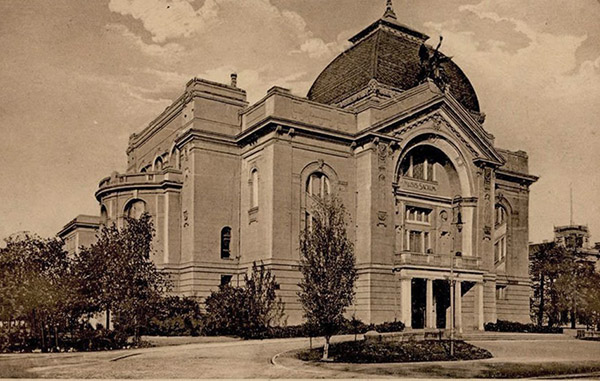
Gera: Theater (Fürstliches Hoftheater)

Gera: Marketplace, 1912
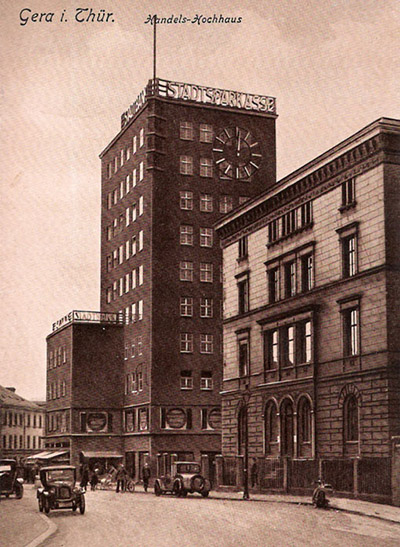
Gera: Handelshof skyscraper
Gera's first skyscraper, built 1929.

Gera: Rossplatz
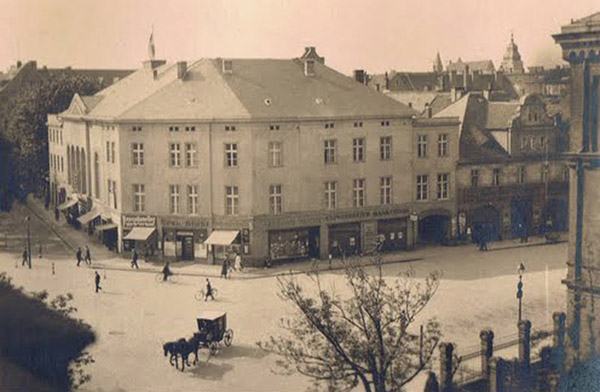
Gera: MargaretenGasse
Margaretengasse where Leo Katz's family lived until 1937 or 1938 was located in the city center, between Roßplatz and Mühlengasse. Margaretengasse was closed in 1958.
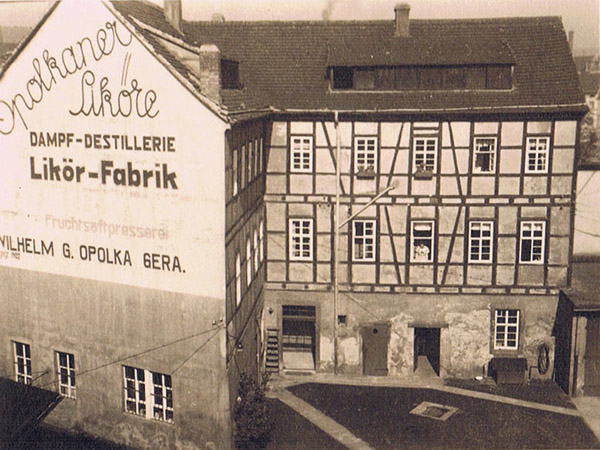
Gera: Opolkaner Schnapsfabrik, 5 Margaretengasse
Leo Katz's family lived 6 Margaretengasse until 1937 or 1938 - across from this building?
Jewish Community in Gera
The first Jewish presence in Gera dates from the mid-1300s; Expelled from the town in the mid-1400s, Jews did not return until 1880. The modern community, formed in 1885, established and maintained a small prayer room.
Jews in Geras made a major contribution to the city's economic, social and cultural development. Towards the end of the 19th century, Jewish entrepreneurs founded their businesses (e.g. the department stores of the Biermann and Jankelowitz families), including a carpet, leather and linen factory and a tailor's shop. One of the best-known companies in Gera was managed by Hermann and Oskar Tietz; Starting out as a small white goods business, they created a department store group that then opened branches in the major cities of Germany. The Tietz department store group was "Aryanized" in 1935/1936.www.xn--jdische-gemeinden-22b.de
In 1878 the Jewish merchant Max Biermann founded a small textile company which became the Biermann department store and developed into the largest store in Gera. At the end of the 1920s, the company employed around 200 clerks, 120 seamstresses and homeworkers. www.xn--jdische-gemeinden-22b.de
The influx of Polish Jews towards the end of the First World War significantly increased the Jewish population in Gera, which grew to a total a peak size of 510 members in 1925, representing 0.6% of the city's total 80,000 inhabitants.
There was hardly any contact between the local and the immigrant “Eastern Jews”. (My mother recalled that German Jews went to one synagogue, while the Ostjuden attended their own and that the communities didn't mix.) The orthodox Jews had their own prayer room on Hospitalstrasse (Karl Liebknecht Straße). To accommodate the growing congregation, the Jewish community convinced the owners of the Hotel Kronprinz on the corner of Schülerstraße and Roßplatz to allow them to build an extension to the hotel to serve as a synagogue. This new synagogue was inaugurated in 1919. The Orthodox Jewish community continued to maintain its own synagogue in Hospitalstraße.
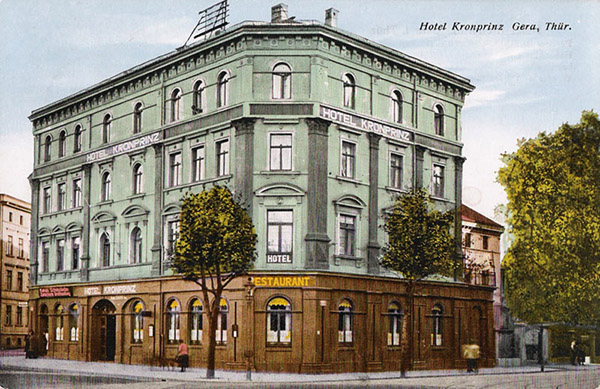
Gera Kronprinz Hotel
There was a Jewish school/community center in the former Meistergässchen, next to Walkmühlenplatz. A teacher was employed to take care of the religious tasks of the congregation who also worked as a prayer leader ("preacher").
The city counted various Jewish associations and organizations, including the charitable and burial association Chevra Kadischa which also provided care for migrants, the Israelite Women's Association and the Israelite Youth Association. More recent additions included the youth association "Blau-Weiß", a local chapter of the Imperial Inion of Jewish Front Soldiers, and, starting in 1935, a local group of the sports club "Bar Kochba". At first, the Nazi authorities tolerated the group, as the regime was toning down its antisemitic policies in preparation for the 1936 Berlin Olympics. This policy later changed and the club would eventually be dissolved after the Gestapo's intervention.
With the Nazi rise to power in 1933, many Jews emigrated and the Jewish population dropped to 378 that year (0,5% of the city's population), down from its 1925 peak, when it counted 510 members. In the following years, more members of the community emigrated due to the economic boycott and increasing deprivation of rights.
By 1938, according to the list set up for their imminent deportation, there were 83 Polish Jews in Gera - 68 adults and 14 children. Other sources mention that 140 "Ostjuden" (Polish Jews) were deported during the October 28, 1938 so-called "Polenaktion". Among them were the three Katz brothers and their families.
A total of 217 Jews from the city were killed in the Holocaust.
Timeline of anti-Jewish measures in Gera and Thuringia.
While anti-Jewish measures would be adopted across all of Germany starting in 1933, Thuringia was in many ways a precursor to the national Nazi takeover of German institutions, with early electoral successes resulting in racial legislation at the state level even before Hitler's rise to power.
-
1923: The first National Socialists in Gera
August (or October?) 1923: The first local branch of the NSDAP (National Socialist German Workers Party) is founded in Gera. The group will soon be banned after the failure of the coup d'état staged by Adolf Hitler on November 9, 1923.
-
February 1924: Participation of the Völkisch-Sozialer Block in the Thuringia parliament
In February 1924, the anti-Semitic writer Arthur Dinter is elected to the state parliament of Thuringia. As a representative of the electoral alliance Völkisch-Sozialer Block ("Peoples Social Bloc"), he demands as a condition of joining a bourgeois minority government "...that Jews be unconditionally removed from all government and civil service (including the Gera city council) ... In the legal sense, we consider as "Jew" a member of the Jewish race, the son or grandson of a member of the Jewish race, baptized or not."
Dinter's demands include "the expulsion of the Eastern Jews who have immigrated to Thuringia since 1914, confiscation of their entire property", a ban on cattle and grain trade for Jews, a professional ban on Jewish doctors, lawyers and notaries, a ban on hiring of Jewish teachers at Thuringian schools and at the University of Jena, a ban on children of Jewish parents from attending public schools.
Although these demands do not succeed, they foreshadow what will be implemented in the years to come.
-
February 5, 1925: The NSDAP in Gera
The local branch of the NSDAP is re-established in Gera, with 12 registered party members.
-
November 1925: Hitler in Gera
Hitler visits Gera for the first time on November 13 with his deputy Rudolf Hess. There are about 1800 people in the establishment "Heinrichstraße". There are protests in front of the bar from Communists and Social Democrats intoning the International.
Hitler returns to Gera on November 25, 1925.
-
May 1926: The first group called "Hitler Youth" is created in Gera
A Hitler Youth group is created for young men between the ages of 14 and 18, it is the first group to bear the name "Hitlerjugend" in the country.
-
September 1927:
Early Nazi violence: Members of the NSDAP smash the windows of two Jewish stores, "Bütow" and "Hermann Tietz". The perpetrators are arrested.
-
1929: The Gera NSDAP gains in strength
The Gera chapter of the NSDAP now counts 146 members.
-
1930: First SA group in Gera
The first group of SA (Sturmabteilung - the paramilitary wing of the NSDAP Party) is created in Gera with about 70 to 80 men.
-
January 1930: Thuringia the first local governement with a National Socialist minister
As the price for joining the coalition government of the Land (state) of Thuringia, the NSDAP receives the state ministries of the Interior and Education. Wilhelm Frick is appointed to these ministries, becoming the first Nazi to hold a ministerial-level post at any level in Germany, making Thuringia the first German local state government with National Socialist participation.
Frick uses his position to dismiss Communist and Social Democratic officials and to replace them with Nazi Party members. Shortly after assuming office in the Thuringia government, Frick issues a decree for the reintroduction of the school prayer, bans several newspapers, and bans Erich Maria Remarque's anti-war novel "All Quiet on the Western Front" in schools. On his order, 70 paintings and graphics are removed from the Weimar Museum as "degenerate art", including works by Otto Dix and Paul Klee. Frick also appoints the eugenicist Hans F. K. Günther as a professor of social anthropology at the University of Jena. On October 1, 1930, the "Chair for Race Questions and Racial Science" is created under the leadership of Günther, helping to establish a scientific basis to the racial ideology of the Nazis. Gunther's "Racial Doctrine" is adopted in the school system by the Thuringian Ministry of Education.
-
July 12, 1930: Hitler in Gera
Hitler gives a speech at the "Heinrichsbrücke" community center at the NSDAP party convention.
-
September 5-6 1931: Hitler in Gera
Hitler comes to Gera on the occasion of the 7th Gauparteitage (the NSDAP's "District Party Day") and gives a speech in the market place. According to the "Geraer Zeitung", 13,000 Hitler supporters attend and march.

Hitler in Gera, 1931. Marktplatz.

The Gera branch of the SA march on NS 1931 "Gautag" (Regional Day).
Collection Werner Simsohn, "Juden in Gera, Vol III".
-
March 12, 1932: Early calls for boycott
Three months before the Reich-wide call of the National Socialist government, Thuringia Minister of the Interior Sauckel calls for a boycott of Jewish businesses in a radio speech.
-
July 26, 1932: Hitler in Gera
Hitler speaks in Gera in the Schützenplatz in front of about 40,000 supporters. His appearance is accompanied by protests by the members of the "Iron Front" and the KPD (Communist Party).
-
July 31, 1932: Reichstag and state elections
In Gera, the Social Democrats receive 20,323 votes, the NSDAP 20,191, and the Communists 6,422. With this election, the NSDAP have almost doubled their results compared to the 10,746 votes they received in the September 1930 vote.
-
December 1932: Increased NSDAP membership
At the end of 1932, the NSDAP in Gera has now 1,413 members and the SA (combat organization) 600 members.
-
January 31, 1933: Torchlight procession of the National Socialists
The NSDAP, SA, SS, and the Hitler Youth march in a torchlight procession in honor of Hitler. A counter-demonstration by the Communists is forcibly disbanded, followed by numerous arrests.
-
February 12, 1933: The first purges in Gera
The National Socialists begin to carry out the first political purges into the town councils of Gera. Social Democrats, Communists and Jews are removed from office and replaced by National Socialists.
-
September 3, 1933: "Rathenau Platz" renamed "Adolf Hitler Platz"
Named after Walther Rathenau, the Jewish Foreign Minister during the Weimar Republic, "Rathenauplatz" is renamed "Adolf Hitler Platz".
-
March 30, 1933: Implementation of the national anti-Jewish boycott in Gera
The "Geraer Beobachter", an NSDAP newspaper, announces the boycott of all Jewish businesses in Gera scheduled for April 1, 1933, and "draws the public's attention to the fact that it is treason to buy from the Jew".
Newspapers in Gera print detailed lists of shops whose owners are Jewish. Among them, for example, the department store of Max Biermann. The headlines in the "Geraer observer", the newspaper of the NSDAP, announces: "Do not buy from the Jew", "Out with Jews from all German courtrooms".
The party leadership issues the following guidelines: "Through SS and SA departments, the population will be warned against entering Jewish shops. Jewish businesses will be designated as such. The beginning of the boycott is scheduled for Saturday, April 1, 1933, at 10 o'clock in the morning."
-
April 1, 1933: The boycott
At 10:00 am on April 1, SA guards stand in front of Jewish shops and inform inhabitants of Gera that shopping in Jewish stores is a "betrayal of their fathers". The department stores of Hermann Tietz and Max Biermann are closed. Shops are marked with the Star of David and covered with anti-semitic slogans.
The boycott continues against Jewish physicians and lawyers. The population is asked to only visit German doctors and lawyers.
-
December 1933: Hitler Youth in Gera
Almost 98% of Gera's male adolescents now belong to the Hitler Youth.
-
July 15, 1933: "Racial Science" in Thuringia
The state of Thuringia establishes a "State Office for Racial Science" in Weimar, the first such institution at the country level. There, a "genetic archive" is created in which 466,000 personal files are archived by 1935. Ultimately, every third inhabitant of the country is captured here.
-
1934:
The Deutsche Arbeitsfrong ("German Labor Front", national labor union) marches in Gera.
The Kampfbund fur Deutsche Kultur ("Fighting League for German Culture") holds an event in Gera. The cultural watchdog organization operated by the Nazi Party was opposed to the involvement of Jewish writers, composers, and artists in German culture, and to other figures who did not fit the organization's concept of German culture under Nazism. The organization held book-burnings and other events.
-
June 17, 1934: Hitler visits Gera
Adolf Hitler visits Gera once again and delivers a speech.
-
1935: Aryanization
The Max Biermann department store in Gera is "Aryanized", along with many other Jewish businesses.
-
July 10, 1935: Further boycott
The mayor of Gera asks the Minister of the Interior, Fritz Sauckel, to include in his official journal a list of all Jewish businesses in Gera. With this measure he wants to ensure that under no circumstances would any of the city officials, employees and workers buy from Jewish shops.
-
August 10, 1935: Further anti-Jewish measures
Jewish stores in Gera are now closed or operated by "Aryans". Jews are no longer allowed to teach, to go to the movies or the theater, and cannot sit on park benches.
-
September 3, 1936: A "forbidden relationship" in Gera
A man who violated the Nuremberg race laws is sentenced in the district court of Gera to six months in prison for maintaining a sexual relationship with a Jewish woman ("defiling the race").
-
May 13, 1938: Aryanization in Gera
The carpet factory "Halpert & Co", one of the leading carpet manufacturers with 1,000 employees is "Aryanized".
-
October 28, 1938: Deportation of Polish Jews from Gera
According to the head of the police of Gera, there are 83 deportable Jews in Gera. All but one of them - because he is away - have been informed they will be deported from Gera the next day. 68 adults and 14 children of Polish nationality are deported on that day, including the three Katz brothers and their families.
According to other sources however, the deportees are rounded up without prior notification in the early morning hours, and about 140 people are deported.
-
November 10, 1938: Kristallnacht
During the November Pogrom of 1938, the two synagogues are desecrated and destroyed. Most of the Jewish men are arrested and taken to the Buchenwald concentration camp.
In the early morning hours of November 10, the SA, the SS and the Hitler Youth destroy the synagogue in the Hotel Kronprinz on Schülerstraße, but decide not to burn it as it's attached to a hotel. Instead, the contents of the synagogue is looted, and Torah scrolls are burned in the streets by the SA. The Orthodox synagogue is burned down. The Jewish school in the Meistergässchen is also destroyed.
The Gera police are instructed not to intervene during the pogrom, as fire brigades across Germany had been told not to fight the synagogue fires, but only to protect the neighborhing properties which belonged to "true Germans".
Members of the NSDAP, SA and SS ransack Jewish apartments and arrest all men aged 16 and over. 38 of the men are taken to the Buchenwald concentration camp near Weimar.
On November 10, 1938, the "Geraer Zeitung" cynically wrote:
"Public outrage against the Jews"
"In order to prevent riots against the Jews, the Jewish men were taken into protective custody. In addition, all Jewish shops in the city were closed. Men of the movement [NSDAP] are on duty in front of these shops to prevent the indignant comrades from smashing the shop windows to pieces."In his report on the pogrom night in Gera, the chief prosecutor Müller writes: "The whole action was without incident."
Among the "Polish" deportees that day were several members of the Katz family: Leo and Frida Katz, Aron, Gustl and Saul Katz, and Mathes and Margule Katz.
-
In 1939 (?), so-called "Jewish houses" are set up where Jews still living in the city are forced to relocate.
-
In 1942, there remain 64 Jews in Gera. Most of them are sent to extermination camps that year during two deportations. On May 9, 1942, 34 Jews, including six children are deported. On September 19th/20th 1942, another 14 Jews are sent to their death in the East.
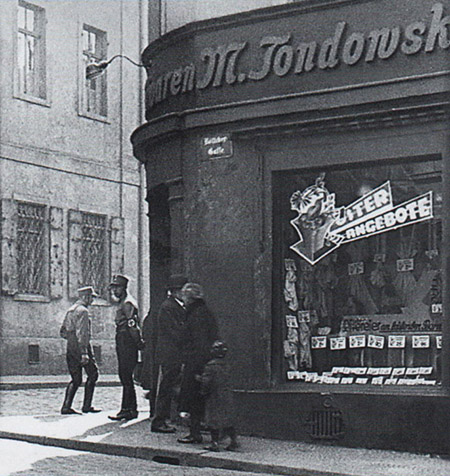
Two SA posted in front of a Jewish store during the April 1, 1933 boycott.
Photo: Herbert Gutte, collection Werner Simsohn, "Juden in Gera, I".

Biermann store on the day of the Nazi boycott, April 1, 1933.
(Photo from "Juden in Gera, I", Werner Simsohn)
In total, about 216 Jews who were born in Gera and/or lived there perished during the Nazi period.
Postscript
Since 2008, around 95 (as of 2021) "stumbling blocks" (Stolpersteine) have been installed in Gera to commemorate Jewish victims of the Nazis.
In June and July 2010, 6 "Stolpersteine" were stolen in Gera.
In October 2012, a memorial plaque was unveiled at the Gera main station to commemorate Jewish citizens who were deported during the Nazi era.
- Sources
- alemannia-judaica.de
- www.gera-chronik.de
- germansynagogues.com
- www.xn--jdische-gemeinden-22b.de
- https://www.lzt-thueringen.de/files/fates_of_jewish_families.pdf
- stolpersteine-gera.de
- List of Stolpersteine in Gera
- Juden in Gera vol I, vol II Publisher: Hartung-Gorre Verlag Konstanz
